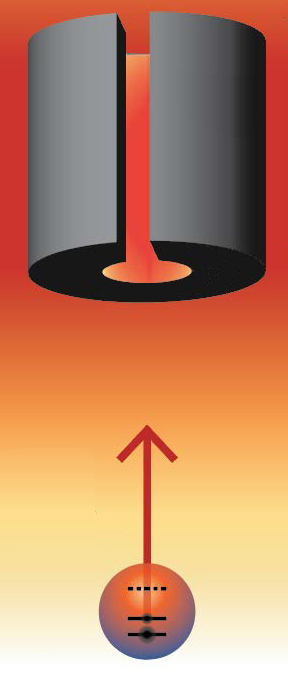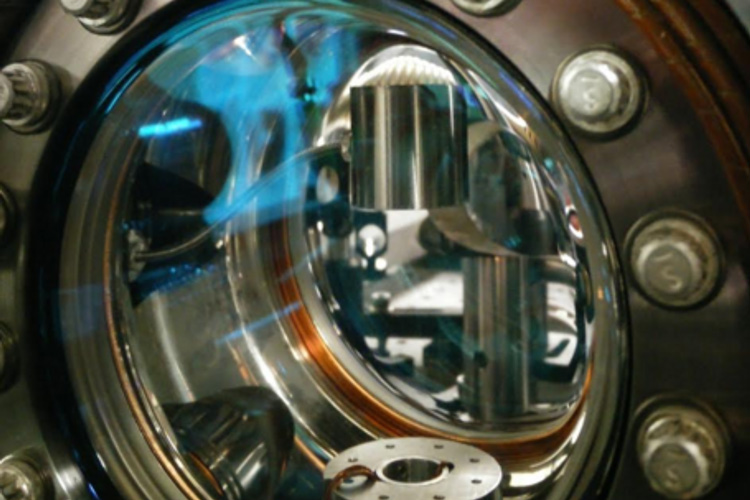Hot bodies are attractive
Physicists find that blackbody radiation from a warm object attracts polarizable objects
December 8, 2017
Our physical attraction to hot bodies is real, according to UC Berkeley physicists.
To be clear, they’re not talking about sexual attraction to a “hot” human body.

The blackbody attraction between a hot tungsten cylinder and a cesium atom is 20 times stronger than the gravitational attraction between them. (Holger Müller graphic)
But the researchers have shown that a glowing object actually attracts atoms, contrary to what most people – physicists included – would guess.
The tiny effect is much like the effect a laser has on an atom in a device called optical tweezers, which are used to trap and study atoms, a discovery that led to the 1997 Nobel Prize in Physics shared by former UC Berkeley professor Steven Chu, now at Stanford, Claude Cohen-Tannoudji and William D. Phillips.
Until three years ago, when a group of Austrian physicists predicted it, no one thought that regular light, or even just the heat given off by a warm object – the infrared glow you see when looking through night-vision goggles – could affect atoms in the same way.
UC Berkeley physicists, who are expert at measuring minute forces using atom interferometry, designed an experiment to check it out. When they measured the force exerted by the so-called blackbody radiation from a warm tungsten cylinder on a cesium atom, the prediction was confirmed.
The attraction is actually 20 times the gravitational attraction between the two objects, but since gravity is the weakest of all the forces, the effect on cesium atoms – or any atom, molecule or larger object – is usually too small to worry about.
“It’s hard to find a scenario where this force would stand out,” said co-author Victoria Xu, a graduate student in the physics department at UC Berkeley. “It is not clear it makes a significant effect anywhere. Yet.”
As gravity measurements become more precise, though, effects this small need to be taken into account. The next generation of experiments to detect gravitational waves from space may use lab-bench atom interferometers instead of the kilometer-long interferometers now in operation. Interferometers typically combine two light waves to detect tiny changes in the distance they’ve traveled; atom interferometers combine two matter waves to detect tiny changes in the gravitational field they’ve experienced.

Thermal images like this record blackbody radiation, essentially the infrared light given off as a body cools. (iStock image)
For very precise inertial navigation using atom interferometers, this force would also have to be taken into account.
“This blackbody attraction has an impact wherever forces are measured precisely, including precision measurements of fundamental constants, tests of general relativity, measurements of gravity and so on,” said senior author Holger Müller, an associate professor of physics. Xu, Müller and their UC Berkeley colleagues published their study in the December issue of the journal Nature Physics.
Optical tweezers
Optical tweezers work because light is a superposition of magnetic and electric fields – an electromagnetic wave. The electric field in a light beam makes charged particles move. In an atom or a small sphere, this can separate positive charges, like the nucleus, from negative charges, like the electrons. This creates a dipole, allowing the atom or sphere to act like a tiny bar magnet.
The electric field in the light wave can then move this induced electric dipole around, just as you can use a bar magnet to shove a piece of iron around.
Using more than one laser beam, scientists can levitate an atom or bead to conduct experiments.
With weak, incoherent light, like blackbody radiation from a hot object, the effect is much weaker, but still there, Müller’s team found.

The shiny tungsten cylinder can be seen at top through a window into the vacuum chamber of the atom interferometer The cesium atoms are launched upwards through the circular opening below the cylinder. (Holger Müller photo)
They measured the effect by placing a dilute gas of cold cesium atoms – cooled to three-millionths of a degree above absolute zero (300 nanoKelvin) – in a vacuum chamber and launching them upward with a quick pulse of laser light.
Half are given an extra kick up towards an inch-long tungsten cylinder glowing at 185 degrees Celsius (365 degrees Fahrenheit), while the other half remain unkicked. When the two groups of cesium atoms fall and meet again, their matter waves interfere, allowing the researchers to measure the phase shift caused by the tungsten-cesium interaction, and thus calculate the attractive force of the blackbody radiation.
“People think blackbody radiation is a classic concept in physics – it was a catalyst for starting the quantum mechanical revolution 100 years ago – but there are still cool things to learn about it,” Xu said.
The research was funded by the David and Lucile Packard Foundation, National Science Foundation (037166), Defense Advanced Research Projects Agency (033504) and National Aeronautics and Space Administration (041060-002, 041542, 039088, 038706, and 036803). Other co-authors are Philipp Haslinger, Matt Jaffe and Osip Schwartz of UC Berkeley, Matthias Sonnleitner of the University of Glasgow, Monika Ritsch-Marte of the Medical University of Innsbruck in Austria and Helmut Ritsch of the University of Innsbruck.
RELATED INFORMATION